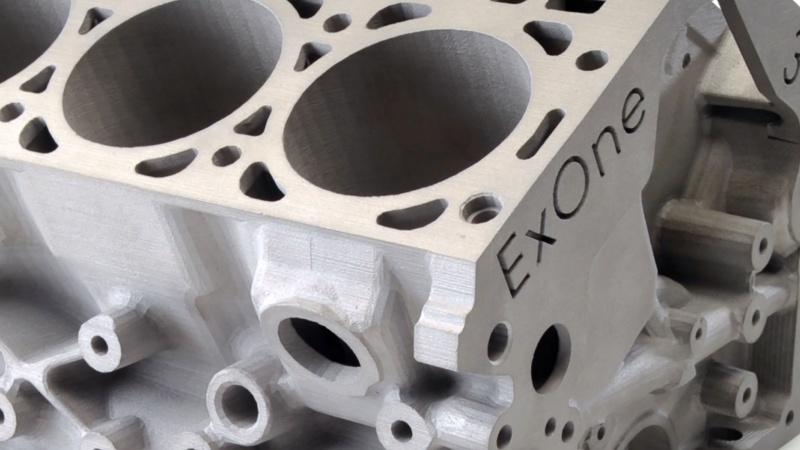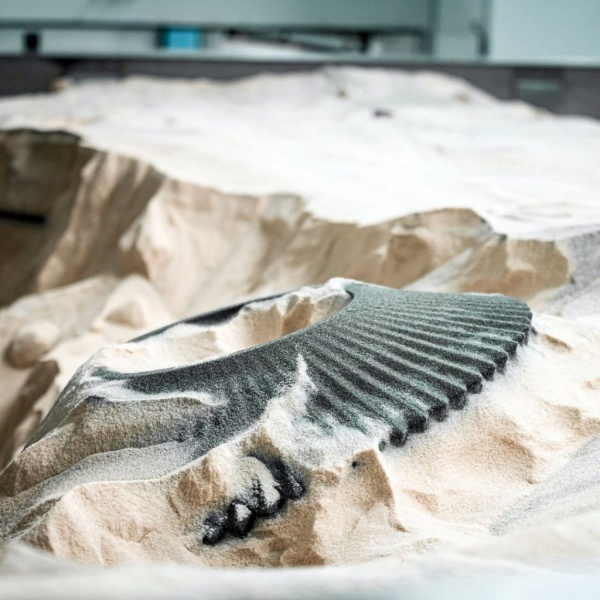
The newly renovated ExOne Metal 3D Printing Adoption Center, located outside of Pittsburgh, now runs continuously with 28 metal 3D printers, including two new metal platforms dedicated to stainless steel part production for industrial customers and service bureaus. Additionally, the center reached a new milestone in June 2021. It surpassed two million 3D printed parts in a wide range of metals, with the production of single-alloy metals. This came following the launch of the company’s exclusive patented Triple Advanced Compaction Technology (ACT) system for dispensing, spreading and compacting the finest powders for more sustainable manufacturing.
The binder jet 3D printing company has been around since 1995, dedicated primarily to creating parts made from powdered metal and sand. However, competition has ramped up in the last years, leading ExOne (Nasdaq: XONE) to push the envelope on its additive manufacturing solutions. As part of its strategy to drive the adoption of its 3D printing systems, it has devised a network of strategically located Adoption Centers, known as EACs, providing industrial 3D printing systems and services to customers considering the purchase of one of its dedicated metal binder jet 3D printing machines. The centers are capable of printing in a variety of industrial materials and industry-leading throughput to serve the needs of industrial customers.

Located across the globe, the EACs produce parts daily on metal AM systems for industrial customers and on-demand manufacturing for service bureaus, such as Sculpteo and Xometry. For example, 3D printing service provider Shapeways has had a 10-year long partnership with ExOne and relied on the company’s binder jet machines to produce more than one million stainless steel pieces.
At ExOne’s Metal 3D Printing Adoption Center in North Huntingdon, Pennsylvania – in operation since 2005 – the firm has recently added two new X1 25Pro metal printers, dedicated to producing stainless steel alloys 316L and 17-4PH. Released in 2019, the production-level industrial system can run continuously for long periods, building objects in a wide variety of metals at relatively cheap costs.

The new machines will join other 3D printers and about a dozen furnaces, including a new, all-metal Elnik MIM3045 debind-and-sinter, high-capacity batch furnace, as well as a continuous furnace. The furnaces allow ExOne to simulate full-size production operations for customers who want to adopt binder jetting for high-volume production. The Adoption Center also offers the company’s most popular and affordable 3D printed metal, known as X1 Metal 420i, which is available in a dozen custom finishes and durable enough for use in plastic injection molding and other tooling applications. The metal matrix composite comprises 60% 420 stainless steel, which is 40% infiltrated with bronze, one of the earliest metals ever processed on ExOne printers. Used for industrial and tooling applications, such as plastic injection molding and blow molding due to its high durability, it is common for consumer goods, like jewelry.
Since 2017, ExOne has been focused on its North American service centers to accelerate its binder jet 3D printing technology adoption. The success of these EACs is so important to the company that ExOne even refocused two production service centers located in Troy, Michigan, and Houston, Texas, into Adoption Centers. The expansions provided a greater variety of its latest binder and material sets, as well as an expanded range of its machine platforms and options. Lately, ExOne has focused on creating more robust, regionally-based material development services and expanding its technical and training services within the EACs.

Aside from the North Huntingdon EAC, ExOne has established a series of centers in Gersthofen, Germany, and Kanagawa, Japan, each certified to ISO 9001:2015 standards with various scopes. As a result, customers can see the 3D printing machines in operation and evaluate their production capabilities before ordering a 3D printing machine or a printed product or service. The company has described the EACs as ideal for minimizing customer risks and maximizing success.
With clients like the Oak Ridge National Laboratory, BMW, and Sandvik, ExOne claims to have developed a low-risk five-step process to successfully move metal production into binder jet 3D printing, engaging customers on the journey to switch to binder jetting technology. While the centers are scalable and have a well-defined footprint that can be easily replicated to serve additional regional markets, ExOne said it focuses on enhancing the existing centers to enable adoption rather than geographic expansion – which is part of the long-term business strategy of the company. Strategically placed in the US and Europe, the EACs are expected to “binder jet your mission-critical sand molds and cores, washout tooling, and metal, ceramic or composite parts.”


